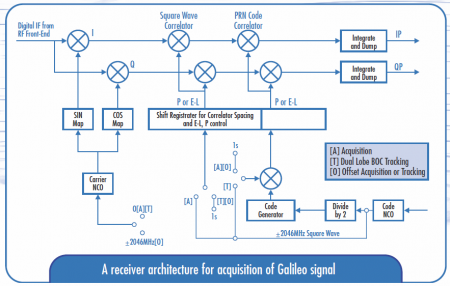If you wish to contribute or participate in the discussions about articles you are invited to contact the Editor
Galileo Receivers
| GALILEO | |
|---|---|
| Title | Galileo Receivers |
| Author(s) | GMV |
| Level | Basic |
| Year of Publication | 2011 |
The Galileo System will be an independent, global, European-controlled, satellite-based navigation system and will provide a number of guaranteed services to users equipped with Galileo-compatible receivers.
Basic elements of a generic GNSS Receiver are an antenna with pre-amplification, an L-band radio frequency section, a microprocessor, an intermediate-precision oscillator, a feeding source, some memory for data storage, and an interface with the user. The calculated position is referred to the antenna phase centre.
Galileo receivers
The Galileo global navigation satellite system will employ many new methods and technologies to offer superior performance and reliability. Development of the advanced receivers required to make use of the system is continuing.[1]
A GALILEO Receiver is a device capable of determining the user position, velocity and precise time (PVT) by processing the signal broadcasted by Galileo satellites. Once the signal is acquired and tracked, the receiver application decodes the navigation message. The navigation data contain all the parameters that enable the user to perform positioning service. The four types of data needed to perform positioning are:[2]
- Ephemeris which are needed to indicate the position of the satellite to the user receiver.
- Time and clock correction parameters which are needed to compute pseudo-range.
- Service parameters which are needed to identify the set of navigation data, satellites, and indicators of the signal health.
- Almanac which are used to compute the position of all the satellites in the constellation with a reduced accuracy, so that the receivers improve the time needed for the initial satellite tracking process.
For single frequency receivers, the Broadcast Group Delays and Ionospheric parameters are also needed.
Three receiver development activities have been initiated within the Galileo programme, addressing the different needs of the system development process and covering the range of signals and services that will be offered.
Activities in receiver development are in the following areas:
- test user segment;
- receivers for the signals transmitted by the first, experimental satellites;
- receivers for the Galileo receiver chain.
Test user segment
The test user segment is being used for system validation and signal experimentation. Two parallel developments have been performed, with the aim of securing equipment availability and achieving the highest confidence in the results. The test user segment consists of:[1]
- a test user receiver for the Open Service, Commercial Service and Safety-Of-Life Service;
- a test user receiver for the Public Regulated Service (PRS);
- Search and Rescue (SAR) test beacon equipment;
- test support tools, such as a simulator for the satellite constellation.
The receivers are based on a highly flexible software-defined concept implementing 14 different receiver configurations. They are able to emulate different receiver classes and provide a variety of internal measurements when combined with an analysis sub-system running on an attached laptop computer.
Experimental satellite receivers
These receivers are being used to receive the signals that are transmitted by the first, experimental satellites GIOVE. They serve both as reference receivers for Galileo sensor stations and as experimental receivers for field tests.
Galileo receiver chain
Galileo sensor stations will be equipped with high-performance, ultra-reliable receivers. The stations provide measurement data to the Galileo system central processing facilities for establishing system integrity and performing satellite orbit determination and time synchronisation.
Commercial Receivers
The GNSS Receivers manufactures have already built multi-constellation receivers designed to deliver centimeter accuracy to a variety of applications. These receivers supports a wide range of satellite signals, including Galileo signals in L1/E5.
Among the companies developing multi-constellation commercial receivers, both in OEM Receiver Boards or Enclosures Receivers:
The corresponding datasheet for each receiver (available in the company website) assures Galileo Signal Tracking, providing Galileo-compatible products compliant to Galileo OS SIS ICD.[2]
First achievements
The objectives of the initial part of the design phase for the test user segment have been fully achieved. A prototype receiver has been constructed, which is capable of receiving all Galileo signal components on all carriers defined in the current specification. The feasibility of acquiring and tracking the new Galileo signals has been proven.[1]
Prototype receivers have also been used for verification of the payloads on the experimental satellites, GIOVE-A and GIOVE-B. They are also being used for validation of the satellite constellation simulator, which emulates the signals as generated by the satellites and modified by environmental effects (due to atmospheric effects, multi-path reception and interference), resulting in a signal that a user receiver would see on the ground.
The Interface Control Document (ICD) for Galileo is available on the European Commission website [3], so receiver manufacturers can already work to prepare the acquisition of real Galileo data.

